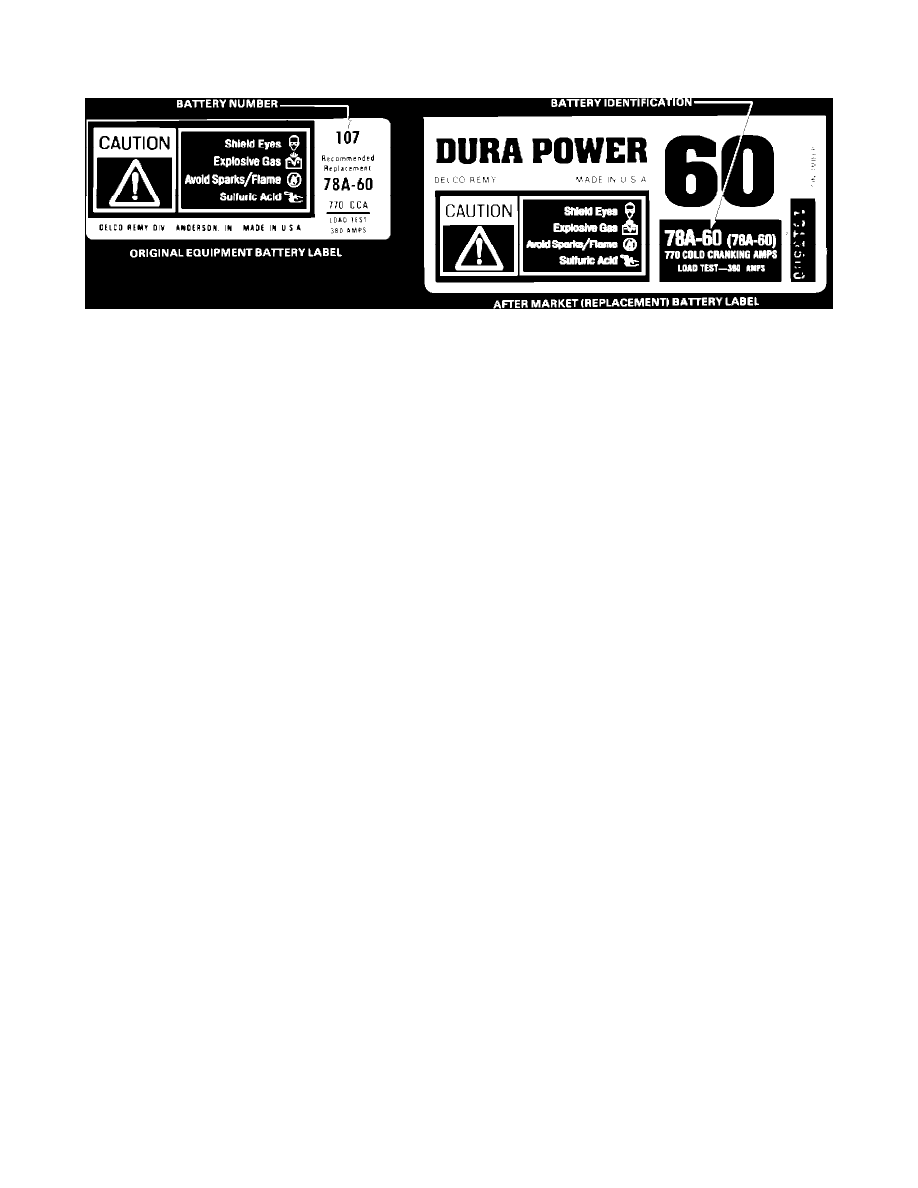Electra V6-181 3.0L (1985)

Fluid Line/Hose: Recalls
Technical Procedure
FIGURE 1 - CAUTION LABELS USED ON BATTERIES TO BE REPLACED
PART A - INSPECTION OF BATTERY
1.
Open vehicle hood, cover fenders, and inspect "Caution" label on top surface of battery. Refer to Figure 1.
a.
Replace batteries identified as original equipment number "107" or aftermarket (replacement) number "78A-60" on "Caution" label following
the complete procedure in PART B of this procedure.
b.
DO NOT replace batteries that are not identified as described in Step "a" above, as no further action is required, except to install a campaign
identification label, PART C of this procedure.
PART B - COMPONENT INSPECTION, CLEANING, REPAIR AND REPLACEMENT
CAUTION: FOLLOW RECOMMENDED PRECAUTIONS IN HANDLING BATTERIES AND POTENTIAL BATTERY ACID
CONTAMINATION COMPONENTS. BATTERY ACID IS CORROSIVE. PROPER PROTECTIVE CLOTHING AND SAFETY
GLASSES SHOULD BE WORN OURING THE FOLLOWING WORK:
1.
Disconnect battery negative cable, positive cable, remove retainer screw and retainer. Carefully remove battery, tag with vehicle
information, and store in a safe area for disposition.
2.
Inspect the following areas for evidence of battery acid. Make note of areas where acid or acid residue is present. Acid residue can
usually be identified as a whitish discoloration or deposit. Acid can result in corrosion or paint peeling or metals and softening and
blistering of rubber and certain plastic compounds.
a.
Battery tray, holddown bolt, and plastic clamp, b. Left inner fender area, c. Left shock tower, d. Left horns, e. Radiator, f.
Lower radiator support, g. Transmission oil cooler lines, hoses, and clamps, h. Power steering oil cooler lines, hold down
bracket and bolt, i. Hood release cable, j. Windshield washer hose, k. Upper radiator hose and clamp at radiator, 1. Air
cleaner housing and inlet area (3.8L engine only),
m.
Hood insulation above battery, n. Engine cradle under battery, o. Side rail under battery, p. Any other suspected contaminated
part in battery area.
3.
If there were no evidence of battery acid found in Step 2, proceed to Step 5 of this procedure to replace transmission cooler hoses
and install new battery. If evidence of acid presence was noted in Step 2, clean affected parts and areas using the following
procedure:
a.
Purchase sodium bicarbonate (baking soda) locally.
b.
Sprinkle affected area with baking soda.
c.
Mix a solution of one (1) part baking soda by volume to one (1) part water.
d.
Brush affected parts and areas liberally with solution, making sure to cover all surfaces.
e.
Let stand until affected area stops gassing (foaming).
f.
Rinse with clean water.
g.
Repeat application five (5) times and rinse.
4.
After neutralizing acid in Step 3, proceed to correct possible degradation, as listed below. Perform only the appropriate steps listed
where acid presence was noted:
STANDARD PAINT REFINISH PROCEDURES SHOULD BE USED WHEN REPAIRING PAINT THAT WAS DAMAGED BY
BATTERY ACID.
